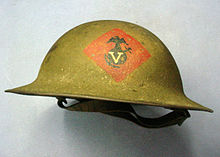Combat helmet


A combat helmet is a type of personal armor designed specifically to protect the head during a fight. Helmets are among the oldest forms of personal protective equipment and are known to have been worn by the Akkadians/Sumerians in the 23rd century BC. Mycenaean Greeks since 17th century BC,[1][2] the Assyrians around 900 BC, ancient Greeks and Romans, throughout the Middle Ages, and up to the end of the 17th century by many combatants.[3] Their materials and construction became more advanced as weapons became more and more powerful. Initially constructed from leather and brass, and then bronze and iron during the Bronze and Iron Ages, they soon came to be made entirely from forged steel in many societies after about 950AD.


At that time, they were purely military equipment, protecting the head from cutting blows with swords, flying arrows, and low-velocity musketry.
Military use of helmets declined after 1670, and rifled firearms ended their use by foot soldiers after 1700.[3] By the 18th century, cavalry units often wore steel body cuirasses, and frequently metal skull protectors under their hats, called "secrets". The Prussian leather spiked helmet, or Pickelhaube, offered almost no protection from the increased use of artillery during World War I, and in 1916 was replaced by the German steel helmet, or Stahlhelm, and afterwards it was worn merely for tradition.[4][5][6]
The Napoleonic era saw ornate cavalry helmets reintroduced for cuirassiers and dragoons in some armies; they continued to be used by French forces during World War I as late as 1915, when they were replaced by the new French Adrian helmet.[7] It was soon followed by the adoption of similar steel helmets by the other warring nations.

World War I and its increased use of artillery had renewed the need for steel helmets, which were quickly introduced by all the combatant nations for their foot soldiers. In the 20th century, such helmets offered protection for the head from shrapnel and fragments.[8]
Today's militaries often use high-quality helmets made of ballistic materials such as Kevlar and Aramid, which offer improved protection. Some helmets also have good non-ballistic protective qualities, though many do not.[9] Non-ballistic injuries may be caused by many things, such as concussive shock waves from explosions, physical attacks, motor vehicle accidents, or falls[10].
Types
Current






World War I - Vietnam
Medieval and early modern militaries
| Model | Origin | Users | Notes |
|---|---|---|---|
| Bascinet | circa 1300 | Europeans during the Hundred Years' War(1337 to 1453) amid the kingdoms of | |
| Burgonet[33] | circa 1600 | Europeans, especially by militias of | |
| Capeline | late 16th century | Europeans during 17th century, including the English Civil War in | |
| Cervelliere | late 13th century | Christian Europeans in Crusades during the 14th century | |
| Great helm[34] | 1189 | Christian Europeans in Third Crusade; other Europeans until 1540 | |
| Kabuto | circa 1600 | Samurai especially during the 17th century of the Edo Period Tokugawa shogunate in Medieval | |
| Pickelhaube[4][5][6] | 1842 | especially by | |
| Sallet | circa 1450 | used in Northern Europe & | |
| Spangenhelm[35] | 5th century | Central Asia, Near East & Europe; espec. by Scythians, Sarmatians, Persians, & Germans until 1000 |
See also headgear listing within Components of medieval armour.
Ancient militaries
| Model | Origin | Users | Notes |
|---|---|---|---|
| Attic helmet | ancient Greeks | ||
| Boar's tusk helmet | 17th century B.C.E. | Mycenaean Greeks until 10th century BCE | |
| Boeotian helmet | ancient Greek cavalry | ||
| Chalcidian helmet | ancient Greeks | ||
| Corinthian helmet[36] | ancient Greeks | ||
| Disc and stud helmet | circa 400 BCE | ancient Illyrians & Adriatic Veneti until 167 BCE | |
| Galea (helmet) | ancient Romans | ||
| Horned helmet | circa 1000 BCE | Celtic Europeans until 700 CE | |
| Illyrian type helmet | ancient Greeks | ||
| Kegelhelm | ancient Greeks | ||
| Negau helmet | ancient Etruscans in Negau, Slovenia | ||
| Pilos | ancient Greeks | ||
| Pot helmet | ancient Illyrians | ||
| Phrygian/Thracian helmet | 400s BCE | ancient Greeks in Thrace, Dacia, Italia & Hellenistic Europe until circa 200 CE |
Various periods
| Model | Origins | Users | Notes |
|---|---|---|---|
| Kettle hat |
References
- ^ Shaft Graves, Mycenae
- ^ Nobuo Komita, The Grave Circles at Mycenae and the Early Indo-Europeans
- ^ a b http://www.nps.gov/archive/colo/Jthanout/HisArmur.html
- ^ a b c German-Helmets.com
- ^ a b c Axis History Factbook: A brief history of the German Stahlhelm
- ^ a b c German Pickelhaube Spiked Helmet Evolution Guide
- ^ a b Heaumes Page
- ^ a b Index CEF Helmets
- ^ Kevlar Pasgt Helmet
- ^ http://www.operation-helmet.org
- ^ MSA: Casques Militaires
- ^ Advanced Combat Helmet ( ACH )
- ^ Advanced Combat Helmet ACH
- ^ US Military Taking Delivery of Advanced Combat Helmets
- ^ The Warrior
- ^ PLCE and Body Armour
- ^ Šestan - Bush d.o.o. (Ltd)
- ^ http://www.grupoinbra.com.br/InbraTextil/ProdutosdeSeguranca/CapacetesEmFibra.aspx
- ^ a b Military Photos: New Australian Combat Helmet
- ^ Canadian Military Police Virtual Museum
- ^ Canada
- ^ http://www.operation-helmet.org/usaf.html
- ^ Department Of The Air Force
- ^ Kevlar Pasgt Helmet
- ^ a b www.militaryphotos.net/forums/showthread.php?t=99988&page=685
- ^ Sistema Compositi SEPT-2 PLUS helmet
- ^ Sistema Compositi SUPERUBOTT helmet
- ^ Tecnoplast TD-71 riot control helmet
- ^ Mile Dragić Production M-97S/P
- ^ Mile Dragić Production M-05S/P
- ^ Българските Военни Каски
- ^ Home of the M-1 Helmet
- ^ myArmoury.com: The Burgonet
- ^ 75years - Great Helms
- ^ Simon Coupland, "Carolingian Arms and Armor in the Ninth Century", (accessed 10 March 2006).
- ^ lookup=Hdt.+4.180.1 Herodotus, The Histories (ed. A. D. Godley)
External links
www.unitedshield.com
